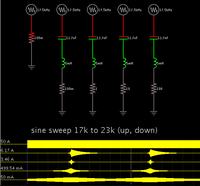Sahil_khan
Newbie level 6
Dear Guys
I am have an the following specifications for my output LC Series filter design;
L = 5mH
Fswitching = 20kHz
Attenuation of 20kHz switching frequency = -60dB
I want to attenuate my 20kHz switching frequency upto -60dB, so How can I calculate my required corner frequency with a decay rate of -40dB/decade ?
After finding the corner frequency then I can calculate my capaciter size by f=1/(2xPixsrt(LxC)).
Thank you all.
I am have an the following specifications for my output LC Series filter design;
L = 5mH
Fswitching = 20kHz
Attenuation of 20kHz switching frequency = -60dB
I want to attenuate my 20kHz switching frequency upto -60dB, so How can I calculate my required corner frequency with a decay rate of -40dB/decade ?
After finding the corner frequency then I can calculate my capaciter size by f=1/(2xPixsrt(LxC)).
Thank you all.
